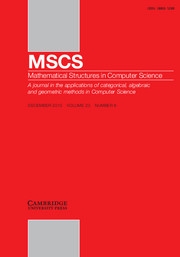Article contents
Borel and Hausdorff hierarchies in topological spaces of Choquet games and their effectivization
Published online by Cambridge University Press: 14 November 2014
Abstract
What parts of the classical descriptive set theory done in Polish spaces still hold for more general topological spaces, possibly T 0 or T 1, but not T 2 (i.e. not Hausdorff)? This question has been addressed by Selivanov in a series of papers centred on algebraic domains. And recently it has been considered by de Brecht for quasi-Polish spaces, a framework that contains both countably based continuous domains and Polish spaces. In this paper, we present alternative unifying topological spaces, that we call approximation spaces. They are exactly the spaces for which player Nonempty has a stationary strategy in the Choquet game. A natural proper subclass of approximation spaces coincides with the class of quasi-Polish spaces. We study the Borel and Hausdorff difference hierarchies in approximation spaces, revisiting the work done for the other topological spaces. We also consider the problem of effectivization of these results.
Information
- Type
- Paper
- Information
- Mathematical Structures in Computer Science , Volume 25 , Special Issue 7: Computing with Infinite Data: Topological and Logical Foundations Part 1 , October 2015 , pp. 1490 - 1519
- Copyright
- Copyright © Cambridge University Press 2014
References
- 8
- Cited by

